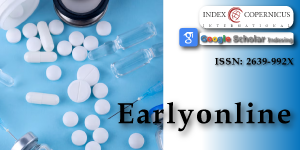Pharmacovigilance is Important for Assessments of Drugs, and Withdrawal of the Drugs that have Adverse Effects More than The Benefits of Their Treatment
Main Article Content
Abstract
Pharmacovigilance is concerned with the adverse effects of the authorized drugs after use, hence if the adverse effects are harmful and deteriorate other organs or tissues of the patient.
These adverse effects were reported by the patients, pharmacists, nurses, clinicians, and physicians. Some examples which withdrawal from the markets according to the pharmacovigilance: astemizole, cisapride, terfenadine, and rofecoxib, which revealed many adverse effects leading to their withdrawal these drugs from the markets.
Aim of the research: The knowledge around pharmacovigilance and improving the side effects of drugs which present in the market, the results of this improvement led us to obtain new drugs without serious side effects.
We conclude that the market drugs improved from the older drugs, have side effects will are suitable to the usage by patients.
Article Details
Copyright (c) 2025 Ayyad RR, et al.

This work is licensed under a Creative Commons Attribution 4.0 International License.
1. World Health Organization. Pharmacovigilance WHO - Regulation and Prequalification. Available from: https://www.who.int/teams/regulation-prequalification/regulation-and-safety/pharmacovigilance
2. Jeetu G, Anusha G. Pharmacovigilance: a worldwide master key for drug safety monitoring. J Young Pharm. 2010;2(3):315-20. Available from: https://doi.org/10.4103/0975-1483.66802
3. World Health Organization. Looking at the Pharmacovigilance: ensuring the safe use of medicines. WHO Policy Perspectives on Medicines. Geneva: World Health Organization. 2004.
4. World Health Organization. The importance of pharmacovigilance: safety monitoring of medicinal products. WHO Lib Catalog. 2002.
5. World Health Organization. Handbook of resolutions and decisions of the World Health Assembly and Executive Board. Geneva: World Health Organization. 1973. Available from: http://whqlibdoc.who.int/wha_eb_handbooks/9241652063_Vol2.pdf
6. Lared NL. Pharmacists’ role in reporting adverse drug reactions in an international perspective. 2003.
7. World Health Organization. WHO Medicines Strategy: Framework for Action in Essential Drugs and Medicines Policy 2000-2003 [last cited on 2010 Jan 10].
8. Olsson S. The role of the WHO Programme for International Drug Monitoring in coordinating worldwide drug safety efforts. Drug Saf. 1998;19(1):1–10. https://doi.org/10.2165/00002018-199819010-00001
9. Coulter DM. The New Zealand intensive medicines monitoring programme in proactive safety surveillance. Pharmacoepidemiol Drug Saf. 2000;9(4):273–80. https://doi.org/10.1002/1099-1557(200007/08)9:4%3C273::aid-pds512%3E3.0.co;2-t
10. Mackay FJ. Post-marketing studies: The work of the drug safety research unit. Drug Saf. 1998;19(5):343–53. https://doi.org/10.2165/00002018-199819050-00002
11. Folb PI, ten Ham M. Drug monitoring in developing countries: A drug regulator’s perspective. Drug Inf J. 1995;29:303–5. Available from: https://doi.org/10.1177/009286159502900133
12. Talbot JC, Nilsson BS. Pharmacovigilance in the pharmaceutical industry. Br J Clin Pharmacol. 1998;45:427–31. Available from: https://doi.org/10.1046/j.1365-2125.1998.00713.x
13. Moore N. The role of the clinical pharmacologist in the management of ADRs. Drug Saf. 2001;24:1–7. Available from: https://doi.org/10.2165/00002018-200124010-00001
14. Hall M, McCormack P, Arthurs N, Feely J. The spontaneous reporting of ADRs by nurses. Br J Clin Pharmacol. 1995;40:173–5. Available from: https://doi.org/10.1111/j.1365-2125.1995.tb05774.x
15. Hornbuckle K, Wu HH, Fung MC. Evaluation of spontaneous adverse event reports by primary reporter: A 15-year review (1983 to 1997). Drug Inf J. 1999;33:1117–24. Available from: https://doi.org/10.1177/009286159903300416
16. Council for International Organizations of Medical Sciences (CIOMS). Benefit-risk balance for marketed drugs. Evaluating safety signals: Report of CIOMS working group IV. Geneva: CIOMS. 1998. Available from: http://www.cioms.ch/publications/g4-benefit-risk.pdf
17. Lazarou J, Pomeranz BH, Corey PN. Incidence of ADRs in hospitalized patients: A meta-analysis of prospective studies. J Am Med Assoc. 1998;279:1200–5. Available from: https://doi.org/10.1001/jama.279.15.1200
18. White TJ, Arakelian A, Rho JP. Counting the costs of drug-related adverse events. Pharmacoeconomics. 1999;15:445–58. Available from: https://doi.org/10.2165/00019053-199915050-00003
19. Avorn J, Solomon DH. Cultural and economic factors that (mis)shape antibiotic use: The nonpharmacologic basis of therapeutics. Ann Intern Med. 2000;133:128–35. Available from: https://doi.org/10.7326/0003-4819-133-2-200007180-00012
20. Ball LK, Evans G, Bostrom A. Risky business: Challenges in vaccine risk communication. Pediatrics. 1998;101:453–8. Available from: https://doi.org/10.1542/peds.101.3.453
21. Bapna JS, Tripathi CD, Tekur U. Drug utilization patterns in the third world. Pharmacoeconomics. 1996;9:286–94. Available from: https://doi.org/10.2165/00019053-199609040-00002
22. Kane A, Lloyd J, Zaffran M, Simonsen L, Kane M. Transmission of hepatitis B, hepatitis C, and human immunodeficiency virus through safe injections in the developing world: mode-based regional estimates. Bull World Health Organ. 1999;78:801–7. Available from: https://pubmed.ncbi.nlm.nih.gov/10593027/
23. de Vries CS, Duggan CA, Tromp TF, de Jong-van den Berg LT. Changing prescribing in the light of tolerability concerns: How is this best achieved? Drug Saf. 1999;21:153–60. Available from: https://doi.org/10.2165/00002018-199921030-00001
24. Sleath B, Svarstad B, Roter D. Physician motivation for non-scientific drug prescribing. Soc Sci Med. 1997;44:541–8. Available from: https://doi.org/10.1016/s0277-9536(96)00213-4
25. Vaccine safety. Vaccine Safety Advisory Committee. Wkly Epidemiol Rec. 1999;74:337–40. Available from: https://pubmed.ncbi.nlm.nih.gov/10613107/
26. European Medicines Agency. Pandemic pharmacovigilance weekly update: Status. 2009. Available from: http://www.ema.europa.eu/pdfs/influenza/78468109en.pdf
27. International Conference on Developing Effective Communications in Pharmacovigilance. Effective communications in Pharmacovigilance. The Erice Report. Erice, Sicily. 1997. [last cited on 2010 Jan 20].
28. Ioannidis JP, Lau J. Completeness of safety reporting in randomized trials: An evaluation of 7 medical areas. JAMA. 2001;285:437–43. Available from: https://doi.org/10.1001/jama.285.4.437
29. Waller PC, Wood SM, Langman MJ, Breckenridge AM, Rawlins MD. Review of company postmarketing surveillance studies. BMJ. 1992;304:1470–2. Available from: https://doi.org/10.1136/bmj.304.6840.1470





